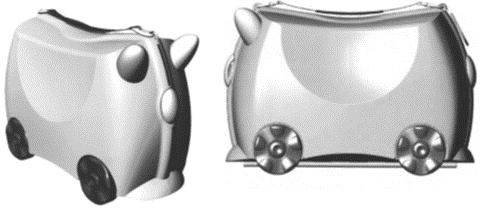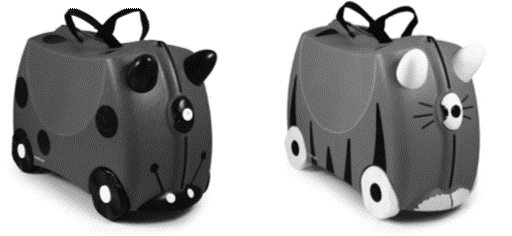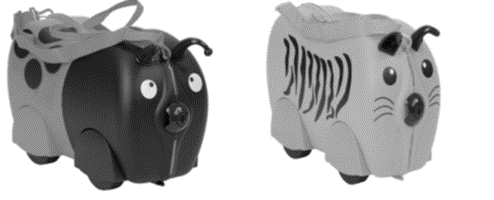Introduction[1]
The Hague Agreement is an international registration system that allows patent and industrial design owners to obtain protection for industrial designs in designated member countries, which are known as “Contracting Parties”. An international application in a single language is filed either through the office of the applicant’s contracting party or with the International Bureau of the World Intellectual Property Organization (WIPO).
The contracting parties include the U.S., the E.U. and 66 other countries. The U.K. and Canada are becoming members. The applicants of U.S. design patents and Canadian industrial designs can file international applications. The applicant must designate the member countries in which rights will be sought at the time of filing.
When a registration is obtained the laws of the designated country will apply to the registration. Like the Madrid Protocol filing international applications will likely only be cost effective when at least 3-4 countries are designated.
Amendments to the Canadian Industrial Design Act
The Canadian Government introduced the Economic Action Plan 2014 Act, No. 2[2] which amended the Industrial Design Act to make that Act consistent with the Geneva (1999) Act of the Hague Agreement Concerning the International Registration of Industrial
[1] . This paper summarizes the comments I made in a webinar presented on March 20, 2018 for the Knowledge Group entitled: The Hague Agreement and Design Filings: Recent Trends and Developments in 2018.
[2]. S.C. 2014, c. 39 not yet in force. It will be brought into force when the new regulations have been finalized.
Designs and to give the Governor in Council the authority to make regulations for carrying it into effect.
The following is a summary of some of the more significant amendments.
The Register of Industrial Designs
Section 3 has been amended to further clarify what information will be contained on the register of Industrial Designs. The register will be evidence of its contents and a copy of an entry in the register is evidence of the particulars of the entry if the copy is appropriately certified as a true copy and admissible in evidence in any court.[1]
The Application
Section 4 has been amended to provide that an application must contain
(a) the name of the finished article in respect of which the design is to be registered;
(b) a representation of the design that complies with any prescribed requirements; and
(c) any prescribed information or statement. [2]
The filing date of an application in Canada will be the date on which the Minister receives the prescribed documents, information and statements or, if they are received on different dates, the latest of those dates. [3]
Under amended section 8.3 the Minister shall make available to the public, on the prescribed date, an application for the registration of a design and all documents in the Minister’s possession relating to the application and to the design’s registration unless the application is withdrawn. [4] The prescribed date may not be later than the later of the date of registration of the design and 30 months after the filing date of the application or any priority date. [5]
Registrability
The amendments set out new grounds to be satisfied to obtain a registration including a requirement for “novelty” instead of “originality”.
The Act has been amended to provide that a design is registrable if
(a) the application is filed in accordance with the Act;
(b) the design is novel, within the meaning of section 8.2;
(c) the design was created by the applicant or the applicant’s predecessor in title;
(d) the design does not consist only of features that are dictated solely by a utilitarian function of the finished article; and
(e) the design is not contrary to public morality or order. [6]
Novelty
Amended section 8.2 provides that a design in an application for the registration of a design is novel if the same design, or a design not differing substantially from it, applied to a finished article that is the same as or analogous to the finished article in respect of which the design is to be registered,
(a) has not been disclosed, more than 12 months before the priority date of the design in the application, in such a manner that it became available to the public in Canada or elsewhere, by
(i) the person who filed the application,
(ii) that person’s predecessor in title, or
(iii) a person who obtained knowledge of the design in the application, directly or indirectly, from the person who filed the application or their predecessor in title;
(b) has not been disclosed by any other person, before the priority date referred to in paragraph (a), in such a manner that it became available to the public in Canada or elsewhere; and
(c) subject to the regulations, has not been disclosed in an application filed in Canada for the registration of a design whose priority date is before the priority date referred to in paragraph (a).
(2) For the purposes of paragraph (1)(c), an application referred to in that paragraph is deemed never to have been filed if it is withdrawn before the earlier of the date on which it is made available to the public under section 8.3 and the date on which a design in it is registered. [7]
While the immediate reaction to this amendment might be that the requirement for “novelty” has raised the bar the wording of the section relates to the comparison of the applied for design with previously disclosed designs. The 12 month grace period is now linked to the priority date of the applied for design instead of the filing date.
The Priority Date
Under the amended Act the priority date of an applied for design is the filing date of the application, unless
(a) the pending application is filed by a person
(i) who, on the filing date of the pending application, is a citizen or national of, or is domiciled in, a country of the Union or has a real and effective industrial or commercial establishment in a country of the Union, and
(ii) who has, or whose predecessor in title has, previously regularly filed an application for the registration of a design disclosing the same design in or for a country of the Union;
(b) the filing date of the pending application is within six months after the filing date of the previously regularly filed application; and
(c) the applicant has made a request for priority in respect of the pending application on the basis of the previously regularly filed application.
(2) In the circumstances set out in paragraphs (1)(a) to (c), the priority date of the design is the filing date of the previously regularly filed application. [8]
Section 29 of the current Act limits claims to priority to claims based on the filing of an application in a foreign country. Under the amended section it will be possible to claim priority on the basis of the filing of an earlier filed Canadian application.
The Term
The duration of the exclusive right has been amended so that it begins on the later of the date of registration of the design and the prescribed date on which the application for the registration of the design is made available to the public and ends on the later of the end of 10 years after the date of registration of the design and the end of 15 years after the filing date of the application. [9]
Utilitarian Function
The Act has been amended to clarify that no protection under the Act shall extend to features applied to a useful article that are dictated solely by a utilitarian function of the article or to any method or principle of manufacture or construction. [10]
Transfer
The amended Act refers to “transfer” instead of “assignment”. It is clarified that an application for the registration of a design can be transferred to another. [11]
The Power to make Regulations
The power to make regulations is substantially increased. [12]
Industrial Design Act Regulations
On December 9, 2017 Canadian Intellectual Property Office published new draft regulations under the Act.[13] The first part of the regulations contains rules that apply to both national and Hague applications unless otherwise specified. The second part of the regulations contains provisions that apply only to Hague applications or registrations.
Some of the key changes to be implemented by the new regulations include:
Applications
Requirements pertaining to the content of the application are aligned with international standards, including those of the Hague Agreement. For example, a description of the design will no longer be mandatory and requirements for representations of the design are amended to be more flexible, allowing the applicant to submit, for example, images in different formats.[14]
One design per application
Currently an application must relate to only one design or variant. If more than one design is disclosed, an applicant is required to limit the application (“original application”) to a single design, or variant, and then file for the previously applied-for designs in their own separate applications (“divisional applications”). The Amendments maintain these principles, but extend the ability to file divisional applications to content not only applied for in the original application, but disclosed, which expands the range of designs that can be the subject of divisional applications. Divisional applications can be further divided subject to time limitations.[15]
Self-Collision
Self-collision arises when an applicant’s earlier registered design or application is too similar to the same applicant’s later filed design and blocks its registration. In such cases, CIPO will refuse to register the later filed design because it lacks novelty over the earlier one. Under the Amendments, when a self-collision situation arises, the later filed design would not be blocked by the initial design if it was filed within 12 months of the filing date of the initial registered design. [16]
Implementation of the Hague Agreement
The Amendments permit applicants to file an international application with WIPO seeking registration in one or many countries, including Canada,that are members of the Hague System.
Once an international application is registered at WIPO on its International Register, it is sent to all designated countries, selected by the applicant as an international registration. If Canada is designated, CIPO then receives the file and divides each design in the International Registration into its own application (called a Hague application) and proceeds with the examination. A notification of refusal can be issued if the Hague application does not meet the substantive criteria for registration, e.g. novelty or insufficient disclosure of the design. WIPO is responsible for the examination of formality requirements (such as those relating to the quality of the representations of the industrial designs) and would inform the applicant of any deficiencies.
Other key provisions of the Amendments:
- permit designs published on the International Register, and a copy of the International Register, to serve as evidence in court. [17]
- permit an international registration in which Canada is designated to be considered equivalent to a national application filed in Canada. This ensures that applicants using the Hague Agreement can secure a filing date even though they have not filed directly with CIPO. Their filing date in Canada would match their international registration date. [18]
Filing Strategies
The key consideration is to develop a filing strategy that will allow the applicant to obtain the degree of protection necessary for the design in issue. There are three key matters which should be considered.
First, multiple applications for different variants of the same finished article can be filed concurrently or within a 12 month period. If shape is of particular importance this should be protected in addition to protecting variants or key features.
Second, an applicant may choose the level of generality at which the design is to be considered. But if the level is too general the design may be invalidated by prior art. If the level is too specific the applicant may not be protected against similar designs.
Finally, the extent of protection afforded to a registered design will ultimately depend on the interpretation of the registration in issue and in particular of the images included in the application.
Some of these considerations are graphically illustrated in the Magmatic case.[19] The case concerned an alleged infringement of a Community Registered Design (the CRD), owned by Magmatic Ltd registered in association with “suitcases”. The CRD consisted of six images prepared by a 3D Computer Assisted Design (CAD) program, in monochrome, with grey-scale shading and distinct tonal contrasts. Two of images are reproduced below:

It appears from these images that the horns, and possibly the front and rear clasps, are differently shaded from the body. It was clear from the six images, viewed collectively, that they are the same light grey shade as the rest of the body, whereas the wheels and spokes, the strap on the top and the strips in the front and the rear are shaded black.
Since May 2004, Magmatic has manufactured and sold ride-on suitcases for children under the trademark “Trunki”. The shape of the suitcases is very similar to that shown on the CRD. The Trunki suitcase was initially marketed with the body and strap one colour, the horns and wheels another colour, and the strips, clasps and wheel-spokes a third colour, but without ornamentation. Later models had slightly different colouring and included ornamentation.
Two examples of such later models, which are based on images contained in Community Registered Designs, applied for in 2010 by Magmatic, are shown below. The images in these later registrations included both coloured CADs with markings and drawings with markings. Two of those registered designs included the CADs shown below:

The first example has a red body, with black horns, nose, spots, bottom front, strip, handles, and wheels, and a white centre to the nose and white spokes. The second example is coloured orange, with horns, front feet, nose and wheels which are white, but with black markings, nose centre, spokes, handles and strip.
In February 2013, Magmatic issued proceedings seeking damages and an injunction against PMS International Group plc, alleging that PMS was importing into, and selling in, the United Kingdom and Germany a “Kiddee Case” which infringed the CRD. These are two examples of a Kiddee Case:

The plaintiff succeeded at trial but was unsuccessful in the U.K. Court of Appeal. The Court said the trial judge first failed to consider the insect version of the Kiddee Case, as the impression its shape creates was clearly influenced by the two tone colouring of the body and the spots on its flanks. As a result it looked like a ladybird and the handles on its forehead looked like antennae. The overall shape conveyed a completely different impression from that of the CRD. It was wrong for the judge to eliminate the decoration on the accused design from his consideration entirely because it significantly affects how the shape itself strikes the eye, and the overall impression it gives. Second, the judge failed to take account of the colour contrast between the wheels and the body of the CRD. This contrast was a fairly striking feature of the CRD which was not present in the accused designs.
An appeal by the plaintiff to the U.K Supreme Court was also unsuccessful. The Court was not persuaded that the Court of Appeal was wrong. They said it was up to the applicant to determine what features are included in the design application. The application can be based on all or any of “the lines, contours, colours, shape, texture … materials … and/or … ornamentation” of the product in question. Further, the applicant can make a large number of different applications and choose the level of generality at which the design is to be considered.
[1]. Section 103 replacing section 3 of the Act.
[2]. Section 104 replacing subsection 4(1) of the Act.
[3]. Section 104 adding subsection 4(3) to the Act.
[4]. Section 105 adding subsection 8.3 to the Act.
[5]. Section 105 adding subsection 8.3(3) to the Act.
[6]. Section 105 adding section 7 to the Act.
[7]. Section 105 adding section 8.2 to the Act.
[8]. Section 106 replacing subsection 10(1) of the Act.
[9]. Section 106 replacing subsection 10(1) of the Act.
[10]. Section 107 adding section 11.1 to the Act.
[11]. Section 108 replacing section 13 of the Act.
[12]. Section 111 replacing paragraphs 25(b) and (c) of the Act.
[13] . Canada Gazette Vol. 151, No. 49. The draft regulations may still be amended but typically amendments at this relatively late stage of the process of implementing regulations are unusual.
[14] . Regulatory Impact Analysis Statement published concurrently with the regulations and sections 14-15.
[15]. Regulatory Impact Analysis Statement published concurrently with the regulations and see section 20.
[16]. Regulatory Impact Analysis Statement published concurrently with the regulations and see section 31.
[17]. Regulatory Impact Analysis Statement published concurrently with the regulations and see section 40
[18]. Regulatory Impact Analysis Statement published concurrently with the regulations and see section 41.
[19] [2014] EWCA Civ 181 (U.K.CA.), [2016] UKSC 12 (U.K.S.C.).
If you have questions, please contact me at mckeown@gsnh.com
John McKeown
Goldman Sloan Nash & Haber LLP
480 University Avenue, Suite 1600
Toronto, Ontario M5G 1V2
Direct Line: (416) 597-3371
Fax: (416) 597-3370
Email: mckeown@gsnh.com
These comments are of a general nature and not intended to provide legal advice as individual situations will differ and should be discussed with a lawyer.
